
The terms prototype and model describe tools frequently used in product design and development processes. There is a certain amount of confusion because the terms are sometimes used interchangeably. In general, however, a prototype is a working representation used to detect flaws or problems in advance of production. A model is a non-working representation used to illustrate the product, and may be constructed at any stage in the product cycle.
Definitions
Video of the Day
The word prototype derives from the Latin words meaning "original" and "form." Thus, a prototype is the "original form" or formulation of the envisioned product. It should be similar enough and have sufficient functionality that the designers and engineers building the product can activate it to carry out the functions of the intended product. The enables the design team to identify any flaws in the product's operation, so that these flaws can be corrected before the production stage.
Video of the Day
The simplest definition of model is a representation, usually three-dimensional, that shows the appearance of something. The "something" being represented can be anything from a person or animal, to a product, style or design, to an abstract scientific concept. The common uses of the term extend far afield into fashion and arts. In engineering and manufacturing, a model is usually a representation that does not have full functionality and is often constructed at a smaller scale than the intended product.
User Interface and Testing
The purpose of a prototype is testing for performance, and the ultimate in prototype testing is done by the end user. The user test pool may be as broadly defined as the entire population of users on a social media platform, for example, or restricted to a specialized group, such as the test pilots who fly experimental aircraft. In all cases, the closer the test pool resembles the actual end users of the product, the more reliable the results will be. In software development, this level of user testing is often known as beta testing, and may apply to the software as a whole or only as a modification of it, like a review feature added to a comment file. If you have ever used or evaluated the beta form of your favorite social media site, for example, you have participated in this kind of prototype testing.
Models, in contrast, are not typically employed in user testing of a developing product. However, models may be used to convey information about the new product to prospective customers, who, ideally, will become end users.
Prototyping
Given the importance of both models and prototypes to the product development cycle, it's no wonder that the word has entered the language in verb form. Prototyping is frequently used as shorthand for the recursive process of product development. A prototype is made, tested, refined and then retested in a loop that may be repeated many times before the design reaches beta testing. Interim versions of the product may be called models, mock-ups or paper prototypes. The overall goal, however, remains the same, which is to get the developing product to a point in which a group of users can have hands-on experience with it, and then provide feedback to the designers. Only then will the developers know if the product is likely to find the customer base it needs to succeed in the marketplace.